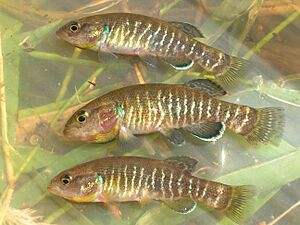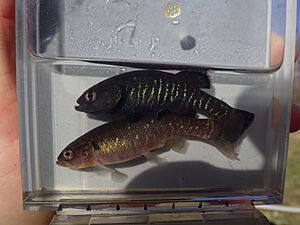Olympic mudminnow facts for kids
Quick facts for kids Olympic mudminnow |
|
|---|---|
 |
|
| Conservation status | |
| Scientific classification | |
| Genus: |
Novumbra
|
| Species: |
hubbsi
|
The Olympic mudminnow (Novumbra hubbsi) is a small fish. It lives only in the western lowlands of Washington. You can find it in the Chehalis River basin, the Deschutes River basin, and some areas on the Olympic Peninsula. This fish can grow up to 8 centimeters (about 3 inches) long. It is the only freshwater fish species found only in Washington state. Even though they look a lot like killifish, mudminnows are actually more closely related to fish like pike and muskellunge.
The Olympic mudminnow is the only living species in its group, called Novumbra. It is one of eight living species in a larger fish family called Umbridae. These fish mostly live in dark, tea-colored waters that move slowly or are still. They can also be found in clear swamps. Olympic mudminnows eat small invertebrates, like tiny insects or worms. They also sometimes eat fish fish larvae or eggs. They like places with muddy bottoms and lots of plants. These fish are amazing because they can handle very low oxygen levels in the water. The state of Washington lists the Olympic mudminnow as a sensitive species. This means their homes are easily lost when land is developed.
Contents
All About the Olympic Mudminnow
The Olympic mudminnow is a unique fish. It has adapted to live in specific types of water. Its ability to survive in low-oxygen environments helps it live where other fish might struggle.
What Do Olympic Mudminnows Eat?
These mudminnows are not picky eaters. They mostly hunt for small creatures without backbones, like insect larvae. They also sometimes eat the eggs or very young fish of other species. They are important parts of their underwater food web.
Where Do Olympic Mudminnows Live?
Olympic mudminnows prefer quiet waters. They like swamps, ponds, and slow parts of rivers. These areas often have muddy bottoms and many plants. The plants give them places to hide and hunt. The water might look dark because of natural materials from plants, like tea.
Reproduction and Life Cycle
Olympic mudminnows start to reproduce after the cold winter months. This happens when the days get longer and the water warms up.
Getting Ready to Spawn
When the water temperature reaches about 14 degrees Celsius (high 50s Fahrenheit), the fish get ready to lay eggs. Female mudminnows become noticeably rounder. Male mudminnows get darker in color. The males then move into special areas they choose for spawning.
How They Lay Eggs
Spawning happens among fine-leaved plants. These can be submerged moss or water wisteria. The male fish tries to get the female to lay her eggs in his chosen spot. The female lays only one or two eggs at a time. This process happens many times. After the female has laid her eggs, the male chases her away from his territory.
From Egg to Fry
The eggs hatch after about 10 days. The tiny baby fish, called fry, stay attached to the plant where they hatched. They stay there until they have used up the food in their yolk sac. After about 7 more days, they start swimming freely. The male mudminnow does not care for the young after they hatch. He only protects his territory from other fish.
Rivalry with Other Fish
Sometimes, the Olympic mudminnow lives in the same areas as another fish called the three-spined stickleback. When it's time to spawn, male sticklebacks also turn black. This similar coloring can cause fights between the male mudminnows and male sticklebacks. They both want to protect their territories.
Why the Name "Olympic Mudminnow"?
This fish is named after a scientist who studied fish. His name was Carl Leavitt Hubbs. So, the fish is named in his honor!



